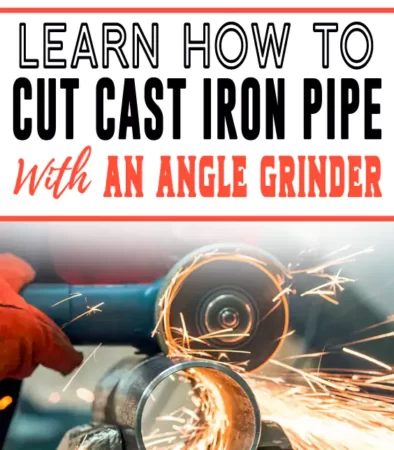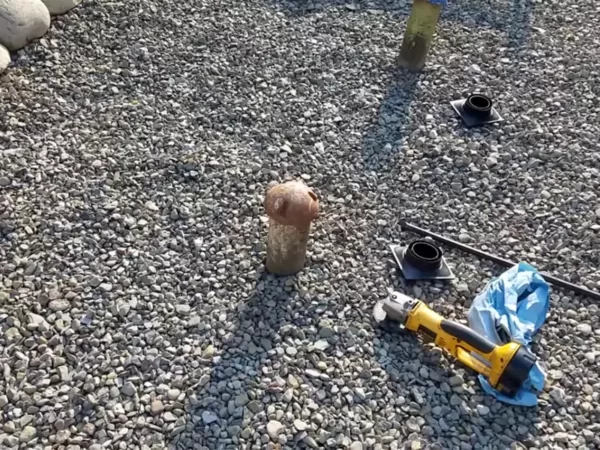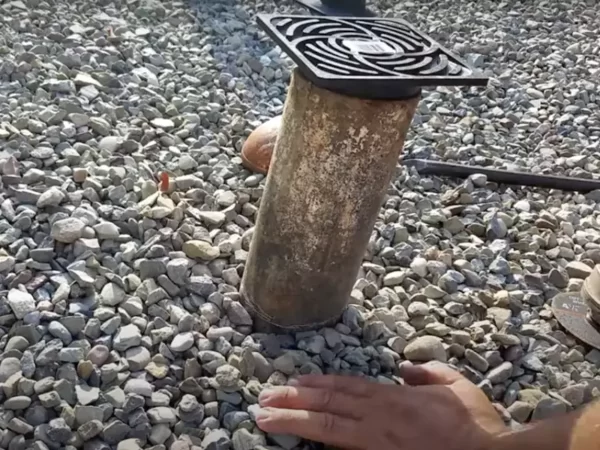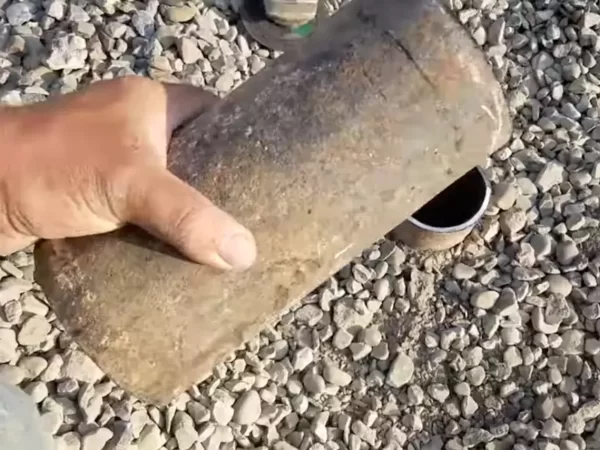Are you searching for effective ways to cut cast iron pipes with an angle grinder? An angle grinder will help you swiftly cut through parts of cast iron pipe. It is a powerful tool with cutting wheels applicable to all types of metals without damage.

5 Steps to Cut Cast Iron Pipe with an Angle Grinder
You don’t have to be a qualified plumber to cut a cast iron pipe. Several methods to cut cast iron drain pipes include Hacksaw, cold chisel, snap cutter, grinder, and a reciprocating saw.
Cold chisel and snap cutter considerably requires more skills and are practically difficult. And, Hacksaw is the slowest method, whereas the remaining two power tools can quickly cut the pipe without much strain.
Using an angle grinder for cutting cast iron pipe is quick and effortless action. Here are step-by-step instructions along with valuable tips for cutting cast iron pipes with an angle grinder.
Step 1: Put the Necessary Things Together

You need to get everything set before starting. Prepare a robust angle grinder with required tools like a diamond wheel or metal cutoff disc. It is better to buy a good quality disc for longevity instead of low-quality discs.
A diamond disc, for instance. You can get them from local shops or online websites. Arrange everything safely in order and fix the metal cutoff disc or a diamond wheel with the grinder using a ratchet to secure it.
Ensure no contact of materials with the ground and keep a distance. Moreover, avoid putting additional force on the blade to prevent injuries. Better to read the given instructions in the manual.
Step 2: Mark the Spot of Cut Carefully

After you have assembled the angle grinder and its accessories, take a marker to select the area you desire to cut.
Mark the section of the pipe using a measuring scale and a pencil or chalk to get accurate results.
Be more careful in this step since any mistake can give off improper results and trouble the quality. Moreover, use bright colors like white or yellow chalk for clear marking.
Step 3: Lay Down the Pipe on the Workbench
You need to place the section of pipe that you want to cut on a worktable utilizing a bench vice and make it a bit stable.
As the cast iron pipe is heavy and sturdy, for this reason, you have to ensure the firmness of a pipe with a clamp.
You are required riser clamps to support at ground level if the pipe is vertically positioned or placed on-site. It will prevent it from falling even after you complete the task.
Step 4: Take Safety Measures
Consider using your Protective Equipment before cutting into the material. A list of PPE items includes a pair of work gloves, a P2 or P3 respirator mask, a flam-resistant long sleeves work shirt, a pair of safety goggles, and steel-capped safety shoes.
Wear all safety equipment in order to protect your eyes, ears, and hands because the angle grinder works at high speed.
Step 5: Start the Angle Grinder
So, have you taken all the necessary safety steps? Let’s fire up the grinder to begin the cutting process. Equip the grinder with a metal cutoff disc or diamond wheel and put the grinder over the marked point.
Then, continue it around the whole perimeter section of pipework to pass the grinding wheel through a single point of the iron pipe.
Moreover, make a groove in the region of the pipe to weaken the pipe. Remove the iron residues during cutting to verify visibility for further process.
Step 5: Confirm the Outcome

The last step includes checking the cut and whether it is precise or not. The total cutting time takes around 45 minutes; however, you may have to continue the process for a few more minutes.
It is because a typical 4-1/2 inch grinder doesn’t show the desired result in one go. It may not drive through larger sections of iron pipe all at once. In addition, use a regular cold chisel if the pipe doesn’t fully cut off.
And pass it through the last remaining segment of pipe to completely snap it off. Driving a chisel is helpful, especially if you are working alone and cannot control the pipe after being cut entirely.
Note: Most importantly, follow all the steps with wearing your protective equipment when cutting steel pipe with an angle grinder.
Related Guides: Cut off a Bolt Head Using an Angle Grinder
Cutting Cast Iron Pipe in a Tight Space

You might face little difficulty if you are not used to working in enclosed spaces. There are a couple of options to cut cast iron. Whatever the method you choose, put on your PPE and ensure a metal cutting blade on the saw or grinder.
Usually, heavy-duty steel pipe and tube cutters are good to use. However, you need an angle grinder or reciprocating saw for tight spaces. Start by marking the section you want to cut and apply moderate pressure.
Try using a carbide-tipped or diamond blade with a reciprocating saw to get an effective cut. It is because such tools are particularly helpful when venturing into tight spaces. You will be able to perform your job without any hazardous sparks.
Besides reciprocating saw, you can also use a snap or soil pipe cutter to be on the safer side. Although it is also expensive, still you can get it cheaply by renting it for the day. Start with a clear path towards a section of pipe and remove hovering cables.
Make sure that both hooks are on the iron pipe when placing the jaws of the pipe cutter square to the pipe. Tighten the ratchet in a clockwise direction to secure the jaws. Gradually, you will determine the pressure via jaws breaking the pipe with a clear cut.
FAQs
1. What Is the Fastest Way to Cut Cast Iron Pipe?
Both saw and grinder can smoothly cut the iron pipe in few minutes. The angle grinder will work efficiently if you apply the right pressure but is a bit more time-consuming.
Therefore, a reciprocating saw with a diamond blade is the fastest way to cut cast iron.
2. What Is the Best Blade to Cut Cast Iron?
The best blade to cut cast iron outfitting a reciprocating saw or angle grinder is a diamond saw blade. It can cut brick, tile, and cast iron in a straight line within a short period.
Using eight inches long diamond blade or a carbide-tipped saw to drive through cast iron will make your job even easier.
3. Is Grinding Cast Iron Dangerous?
Even though grinding cast iron involves relatively less toxicity than other metals, still exposure to iron oxide is dangerous. Abrasives and dust exposure can be hazardous to the eyes.
However, maintain high standards of cleanliness and wear protective clothing. Use safety gloves to protect your hands as grinders work at high speed.
Cast iron pipework is usually found in older homes, and maybe your plumbing pipes are made from cast iron pipes. Therefore, it is important to know the best way to cut the cast iron pipe.
Among so many methods, cutting cast iron with an angle grinder is the most powerful method. It can handle loads of work effortlessly with the right amount of applied pressure. Outfit the saw or grinder with a diamond blade for a smoother cut.
Recent Posts
Many DIY lovers and engineers want to build something cool in their garages. What's cooler than a kit airplane? In this setup, the builder receives parts and puts them together in their own space....
Diamond blades have various uses, from cutting tiles and glass to cutting gems and semiconductor materials. If you’re planning to start a renovation or building project, you’ll need a diamond...
